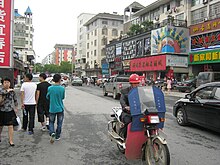| Yi-Liu | |
|---|---|
| Yichun | |
| Native to | China |
| Region | Central and western Jiangxi |
| Language family | Sino-Tibetan |
| Writing system | Chinese characters |
| Language codes | |
| ISO 639-3 | None (mis) |
| ISO 639-6 | yilu |
| Glottolog | yili1247 |
| Linguasphere | 79-AAA-faf |
 Map of Gan languages; Yi-Liu-speaking region in yellow. Map of Gan languages; Yi-Liu-speaking region in yellow. | |
| This article contains IPA phonetic symbols. Without proper rendering support, you may see question marks, boxes, or other symbols instead of Unicode characters. For an introductory guide on IPA symbols, see Help:IPA. | |

Yi-Liu, sometimes called Yichun (simplified Chinese: 宜春话; traditional Chinese: 宜春話) after its principal dialect, is one of the Gan Chinese languages. It is spoken in Yichun in Jiangxi province and in Liuyang in Hunan, after which it is named, as well as in Shanggao, Qingjiang, Xingan, Xinyu City, Fen yi, Pingxiang City, Fengcheng, Wanzai in Jiangxi and in Liling in Hunan.
Sounds
The Yichun variety will be taken as representative.
Consonants
| Bilabial | Alveolar | Alveolo- palatal |
Post- alveolar |
Velar | Glottal | ||
|---|---|---|---|---|---|---|---|
| Nasal | m | ɲ | ŋ | ||||
| Plosive | aspirated | pʰ | tʰ | kʰ | |||
| unaspirated | p | t | k | ||||
| Affricate | aspirated | tsʰ | tɕʰ | tʃʰ | |||
| unaspirated | ts | tɕ | tʃ | ||||
| Fricative | f | s | ɕ | ʃ | h | ||
| Lateral approximant | l | ||||||
Tones

| Tone number | Tone name | Tone contour | Examples |
|---|---|---|---|
| 1 | dark level (阴平) | ˨˦ (25) | 多家彪都姑波编邦 |
| 2 | light level (阳平) | ˦ (44) | 婆爬钱磨驴朋肥扶 |
| 3 | rising sheng (上声) | ˧˩ (31) | 左努改讨巧草拐苦 |
| 4 | light departing (去声) | ˨˩˧ (213) | 大树害饭谢用望漏 |
| 5 | departing sheng (入声) | ˥ (55) | 月六黑割发白湿毒 |
References
- ^ Ma, Xiaoqin 马晓勤 (2006). Yíchūnhuà shēngdiào xìtǒng de shíyàn yánjiū 宜春话声调系统的实验研究 (in Chinese). Tianjin zhong yiyao daxue.
| Sino-Tibetan branches | |||||
|---|---|---|---|---|---|
| Western Himalayas (Himachal, Uttarakhand, Nepal, Sikkim) |
|  | |||
| Eastern Himalayas (Tibet, Bhutan, Arunachal) | |||||
| Myanmar and Indo- Burmese border |
| ||||
| East and Southeast Asia |
| ||||
| Dubious (possible isolates) (Arunachal) |
| ||||
| Proposed groupings | |||||
| Proto-languages | |||||
| Italics indicates single languages that are also considered to be separate branches. | |||||
| Chinese language | ||||||||||||||||||||||||||||||||||||||||||||||||||||||||||||||||||||||||||||||||||||||||||||||
|---|---|---|---|---|---|---|---|---|---|---|---|---|---|---|---|---|---|---|---|---|---|---|---|---|---|---|---|---|---|---|---|---|---|---|---|---|---|---|---|---|---|---|---|---|---|---|---|---|---|---|---|---|---|---|---|---|---|---|---|---|---|---|---|---|---|---|---|---|---|---|---|---|---|---|---|---|---|---|---|---|---|---|---|---|---|---|---|---|---|---|---|---|---|---|
| Sinitic languages | ||||||||||||||||||||||||||||||||||||||||||||||||||||||||||||||||||||||||||||||||||||||||||||||
| ||||||||||||||||||||||||||||||||||||||||||||||||||||||||||||||||||||||||||||||||||||||||||||||
| ||||||||||||||||||||||||||||||||||||||||||||||||||||||||||||||||||||||||||||||||||||||||||||||
| ||||||||||||||||||||||||||||||||||||||||||||||||||||||||||||||||||||||||||||||||||||||||||||||
| ||||||||||||||||||||||||||||||||||||||||||||||||||||||||||||||||||||||||||||||||||||||||||||||
| Jiangxi topics | |
|---|---|
| Nanchang (capital) | |
| General | |
| Geography | |
| Education | |
| Culture | |
| Visitor attractions | |
This Sino-Tibetan languages-related article is a stub. You can help Misplaced Pages by expanding it. |
